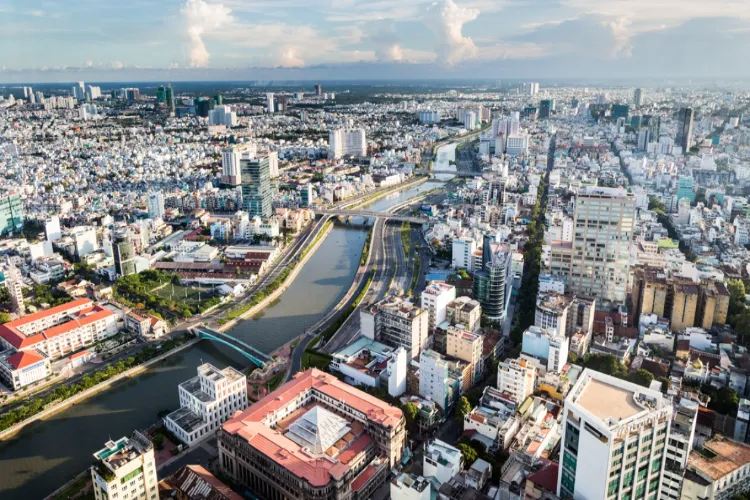
Md. Zishan
A five-and-a-half-hour flight transported me to a world rich in unique customs, cuisine, landscapes, language, and people. As I arrived in Ho Chi Minh City, I was welcomed by the golden glow of the sun, the aroma of freshly brewed coffee, and the tantalizing scents of Vietnamese street food wafting through the air.
It was a refreshing contrast to the polluted air I left behind in Delhi. The warmth and friendliness of the Vietnamese people make the experience even more enjoyable.
Although English is not widely spoken, the Vietnamese greet foreigners with openness and hospitality, bridging language and cultural gaps with patience and kindness. Indian languages, too, are unfamiliar to them, and their folklore and festivals have little in common with those of the Indian subcontinent.
The air in the streets of Dong Khoi, Nguyen Hue, Le Loi, Bui Vien, and Pham Ngoc Thach cities, is filled with the aroma of Vietnamese dishes from lively food stalls.
These cultural differences didn't come in the way of the love story of Bobby, a young man from Punjab, India, who owns a restaurant in Ho Chi Minh City, and his Vietnamese wife. I asked him how he navigated a relationship with such a cultural divide. Bobby replied, “It’s not hard to live together if both partners understand each other.”
His response, though brief, echoed the timeless wisdom that love knows no borders.
Bobby and his wife have two children; the elder attends a local school while the younger is still too young. As a Punjabi, Bobby grew up with a distinct palate, yet his in-laws go out of their way to accommodate him by preparing Indian dishes for family gatherings. “They make sure I get food to my taste and choice whenever I visit,” he chuckles.
Bobby isn’t alone; there are several Indians, particularly from Punjab and Gujarat, who have made similar connections and are now part of the Indian diaspora in Vietnam. These communities run eateries that cater to locals and visiting Indians alike.
I visited Ho Chi Minh City recently on an invitation from the Asian Congress for Media and Communication. I presented a paper titled “Deepfakes and Misinformation: A Socio-Legal Analysis in the Indian Context” at a three-day international conference hosted in collaboration with the University of Social Sciences and Humanities and Vietnam National University.
My brief stay allowed me to get a glimpse into the life of this historic city.
Vietnamese cuisine differs significantly from Indian cooking. The Vietnamese generally prefer boiling and simmering, avoiding the heavily spiced, oil-based methods common in India, such as frying, grilling, roasting, and poaching.
Their food retains a natural taste and aroma by relying on minimal oil. Soups are a staple; pho (a noodle soup) and bun bo Hue (a spicy beef noodle soup) are popular. Steamed dishes like banh bao (steamed buns) and banh cuon (steamed rice rolls) are common foods.
Grilling is reserved mainly for marinated meats and seafood and yet done sparingly to maintain a smoky, charred flavor that complements various sauces.
The city offered an array of Vietnamese delicacies at the conference. For those preferring simpler fare, a Jain meal option—largely vegan—was provided, complete with steamed rice, fried tofu with mushrooms, and vegetable soup enriched with beans, carrots, cabbage, and radishes. While wine flowed freely, water was sold at a premium, with bottles priced between 10,000 and 20,000 Dong (1 Indian Rupee equals 299.74 Vietnamese Dong)
The War Remnants Museum in Ho Chi Minh City preserves Vietnam's turbulent history, particularly its fight for independence from colonial powers. Exhibits of tanks, warplanes, helicopters, and artillery stand as stark reminders of the devastation wrought by war. Photographs taken by war correspondents reveal the trauma of battle, with images that haunt visitors long after they leave.
A section of the museum is dedicated to the horrors of Agent Orange, a toxic chemical used during the war that left a trail of human and environmental destruction. The replicas of prison cells recount the brutality inflicted on Vietnamese prisoners during decades of conflict.
However, Vietnam’s story didn’t end with the war. Over the following decades, the people of Vietnam have moved beyond destruction to rebuild their country.
Ho Chi Minh City is a vibrant hub for tourists and professionals from around the world, adding a cosmopolitan flavor to the city’s cultural fabric. Locals have adapted quickly to visitors’ needs, using technology and translation apps to facilitate communication. The residents are largely disciplined, adhering to traffic rules and maintaining the cleanliness that characterizes the city’s streets.
(The author is an Assistant Professor at the Centre of Mass Communication and Media Studies at Jamia Hamdard, New Delhi)
